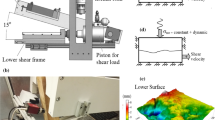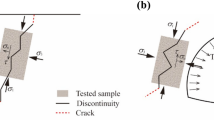Abstract
The relationship between slip velocity, resistance to shear, and geometrical evolution of initially rough limestone surfaces is investigated in servo-controlled direct shear experiments. We focus on shear stress evolution throughout the deformation process, as function of the shear rates applied. Direct shear tests are performed on tensional fractures positioned in a perfectly mating configuration, using a hydraulic, closed-loop, servo-controlled system. The discontinuities are sheared to prescribed displacement target of 10 mm under a constant normal stress of 5 MPa while shear stress and dilation are recorded under controlled shear rates between 0.1 and 50 µ/s. Surface geometry is measured using laser profilometer before and after tests, and roughness evolution is statistically quantified. We find that, before peak shear stress is attained, the shear stiffness increases with slip velocity, manifesting asperity strain hardening during this largely elastic deformation stage. Peak shear stress and stress drop, however, are both inversely proportional to velocity, indicating velocity weakening coupled with rate-dependent healing of the interfaces. The final roughness of the sheared surfaces increases moderately with increasing slip velocity indicating enhanced fragmentation and brittle deformation with increasing shear rate.






Similar content being viewed by others
References
Atapour H, Moosavi M (2014) The influence of shearing velocity on shear behavior of artificial joints. Rock Mech Rock Eng 47:1745–1761
Badt N, Hatzor YH, Toussaint R, Sagy A (2016) Geometrical evolution of interlocked rough slip surfaces: the role of normal stress. Earth Planet Sc Lett 443:153–161
Barton N (1976) The shear strength of rock and rock joints. Int J Rock Mech Min 13:255–279
Biran O, Hatzor YH, Ziv A (2009) Micro-scale roughness effects on the friction coefficient of granite surfaces under varying levels of normal stress. In: Hatzor Y, Sulem J, Vardoulakis I (eds) Shear physics at the meso-scale in earthquake and landslide mechanics. CRC Press, Boca Raton, pp. 145–158
Boneh Y, Reches ZE (2017) Geotribology-Friction, wear, and lubrication of faults. Tectonophysics
Boneh Y, Sagy A, Reches Z (2013) Frictional strength and wear-rate of carbonate faults during high-velocity, steady-state sliding. Earth Planet Sci Lett 381:127–137
Bowden F, Tabor D (1950) The friction and lubrication of solids. Oxford University Press, Oxford
Brodsky EE, Kirkpatrick JD, Candela T (2016) Constraints from fault roughness on the scale-dependent strength of rocks. Geology 44:19–22
Brown SR, Scholz CH (1985) Broad bandwidth study of the topography of natural rock surfaces. J Geophys Res 90:12,575–512,582
Byerlee J (1978) Friction of rocks. Pure appl Geophys 116:615–626
Byerlee JD, Brace WF (1968) Stick slip, stable sliding, and earthquakes—effect of rock type, pressure, strain rate, and stiffness. J Geophys Res 73:6031–6037
Candela T, Renard F, Klinger Y, Mair K, Schmittbuhl J, Brodsky EE (2012) Roughness of fault surfaces over nine decades of length scales. J Geophys Res-Solid Earth 117
Chester FM, Chester JS (2000) Stress and deformation along wavy frictional faults. J Geophys Res: Solid Earth 105(B10):23421–23430
Cook NGW (1992) Natural jonts in rock—mechanical, hydraulic and seismic behavior and properties under normal stress. Int J Rock Mech Min Sci Geomech Abstracts 29:198–223
Crawford AM, Curran JH (1981) The influence of shear velocity on the frictional resistance of rock discontinuities. Int J Rock Mech Min 18:505–515
Davidesko G, Sagy A, Hatzor YH (2014) Evolution of slip surface roughness through shear. Geophys Res Lett 41:1492–1498
Di Toro G, Han R, Hirose T, De Paola N, Nielsen S, Mizoguchi K, Ferri F, Cocco M, Shimamoto T (2011) Fault lubrication during earthquakes. Nature 471:494–494+
Dieterich JH (1972) Time-dependent friction in rocks. J Geophys Res 77:3690–3697
Dieterich JH (1979) Modeling of rock friction, 1: Experimental results and constitutive equations. J Geophys Res 84:2161–2168
Fang ZJ, Dunham EM (2013) Additional shear resistance from fault roughness and stress levels on geometrically complex faults. J Geophys Res-Sol Ea 118:3642–3654
Goodman RE (1974) The mechaincal properties of joints. In: Proc. 3rd Conference ISRM, Denver CO, pp. 127–140
Goodman RE (1989) Introduction to rock mechanics, 2nd edn. Wiley, New York
Grasselli G, Egger P (2003) Constitutive law for the shear strength of rock joints based on three-dimensional surface parameters. Int J Rock Mech Min 40:25–40
Harbord CWA, Nielsen SB, De Paola N, Holdsworth RE (2017) Earthquake nucleation on rough faults. Geology 45:931–934
Heard HC (1963) Effect of large changes in strain rate in the experimental deformation of Yule marble. J Geol 71:162
Ide S (2013) The proportionality between relative plate velocity and seismicity in subduction zones. Nat Geosci 6(9):780
Ladanyi B, Archambault G (1970) Simulation of shear behaviour of a jointed rock mass. In: Proc. 11th Symposium on Rock Mechanics. AIME, New York, pp. 105–125
Lajtai EZ, Duncan EJS, Carter BJ (1991) The effect of strain rate on rock strength. Rock Mech Rock Eng 24:99–109
Liu QS, Tian YC, Ji PQ, Ma H (2018) Experimental investigation of the peak shear strength criterion based on three-dimensional surface description. Rock Mech Rock Eng 51:1005–1025
Marone C (1998) The effect of loading rate on static friction and the rate of fault healing during the earthquake cycle. Nature 391:69–72
Muhuri SK, Dewers TA, Scott Jr TE, Reches ZE (2003) Interseismic fault strengthening and earthquake-slip instability: Friction or cohesion? Geology 31(10):881–884
Nayak PR (1971) Random process model of rough surfaces. J Lubr Technol 93:398
Nishikawa T, Ide S (2014) Earthquake size distribution in subduction zones linked to slab buoyancy. Nat Geosci 7(12):904
Ohnaka M (2003) A constitutive scaling law and a unified comprehension for frictional slip failure, shear fracture of intact rock, and earthquake rupture. J Geophys Res-Solid Earth 108
Patton FD (1966) Multiple modes of shear failure in rock. In: Proc. 1st congr. Int. Soc. Rock Mech. ISRM, Lisbon, pp. 509–513
Persson BNJ (2006) Contact mechanics for randomly rough surfaces. Surf Sci Rep 61:201–227
Power WL, Tullis TE, Weeks JD (1988) Roughness and wear during brittle faulting. J Geophys Res-Solid Earth Planets 93:15268–15278
Rangers N (1970) Influence of surface roughness on friction properties of rock planes. In: Proc. 2nd Cong. ISRM, Bergrade, pp. 229–234
Reches Z, Lockner DA (2010) Fault weakening and earthquake instability by powder lubrication. Nature 467:452-102
Ruina A (1983) Slip instability and state variable friction laws. J Geophys Res 88:10,359–310,370
Rutter EH (1972) Effects of strain-rate changes on strength and ductility of solenhofen limestone at low temperatures and confining pressures. Int J Rock Mech Min Sci 9:183–189
Sagy A, Brodsky EE, Axen GJ (2007) Evolution of fault-surface roughness with slip. Geology 35:283–286
Saucier F, Humphreys E, Weldon R (1992) Stress near geometrically complex strike-slip faults: application to the San Andreas fault at Cajon Pass, southern California. J Geophys Res: Solid Earth 97(B4):5081–5094.
Scholz CH (1998) Earthquakes and friction laws. Nature 391(6662):37
Seidel JP, Haberfield CM (2002) A theoretical model for rock joints subjected to constant normal stiffness direct shear. Int J Rock Mech Min 39:539–553
Tal Y, Hager BH, Ampuero JP (2018) The effects of fault roughness on the earthquake nucleation process. J Geophys Res-Solid Earth 123:437–456
Tesei T, Carpenter BM, Giorgetti C, Scuderi MM, Sagy A, Scarlato P, Collettini C (2017) Friction and scale-dependent deformation processes of large experimental carbonate faults. J Struct Geol 100:12–23
Thomson DJ (1982) Spectrum estimation and harmonic-analysis. Proc IEEE 70:1055–1096
Tsutsumi A, Shimamoto T (1997) High-velocity frictional properties of gabbro. Geophys Res Lett 24:699–702
Wang KL, Bilek SL (2011) Do subducting seamounts generate or stop large earthquakes? Geology 39, 819–822
Zhao J (1997) Joint surface matching and shear strength.B. JRC-JMC shear strength criterion. Int J Rock Mech Min Sci 34:179–185
Zielke O, Galis M, Mai PM (2017) Fault roughness and strength heterogeneity control earthquake size and stress drop. Geophys Res Lett 44:777–783
Acknowledgements
This research is funded by Israel Science Foundation through contract no. ISF 937/17. We thank Ze’ev Reches and another anonymous reviewer for reviewing an earlier version of this manuscript and for their helpful comments.
Author information
Authors and Affiliations
Corresponding author
Additional information
Publisher’s Note
Springer Nature remains neutral with regard to jurisdictional claims in published maps and institutional affiliations.
Rights and permissions
About this article
Cite this article
Morad, D., Hatzor, Y.H. & Sagy, A. Rate Effects on Shear Deformation of Rough Limestone Discontinuities. Rock Mech Rock Eng 52, 1613–1622 (2019). https://doi.org/10.1007/s00603-018-1693-9
Received:
Accepted:
Published:
Issue Date:
DOI: https://doi.org/10.1007/s00603-018-1693-9




